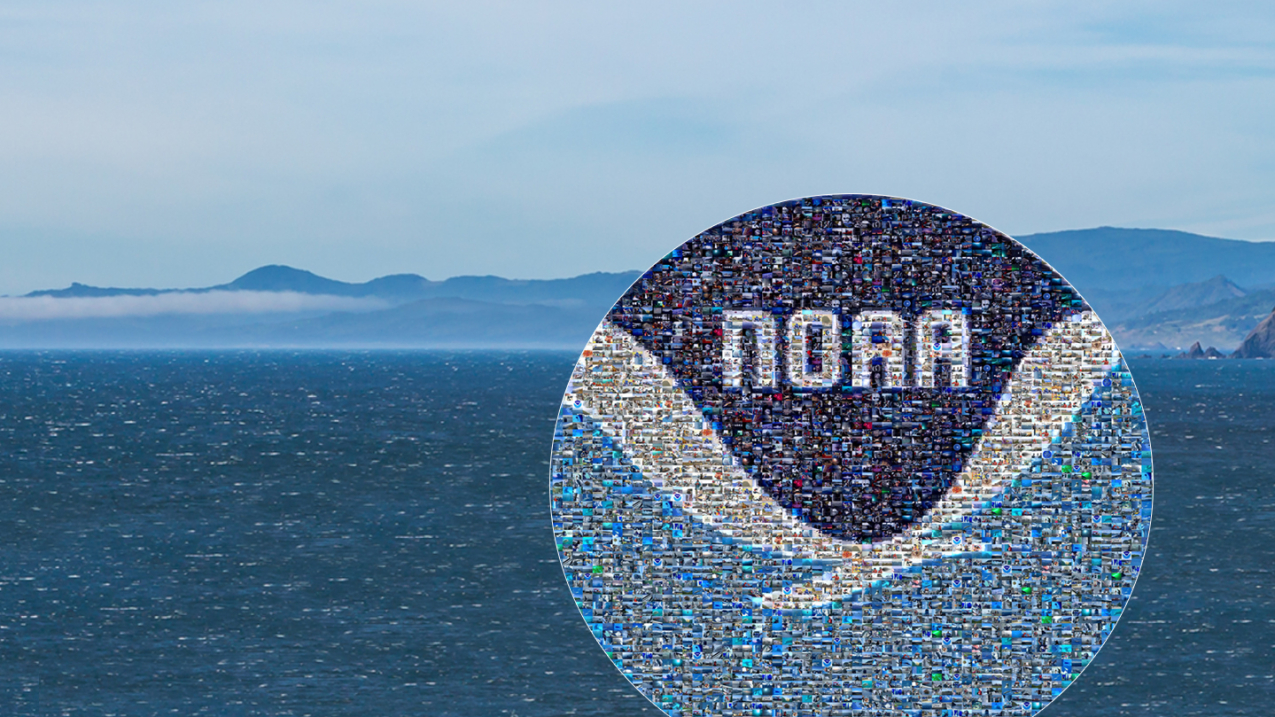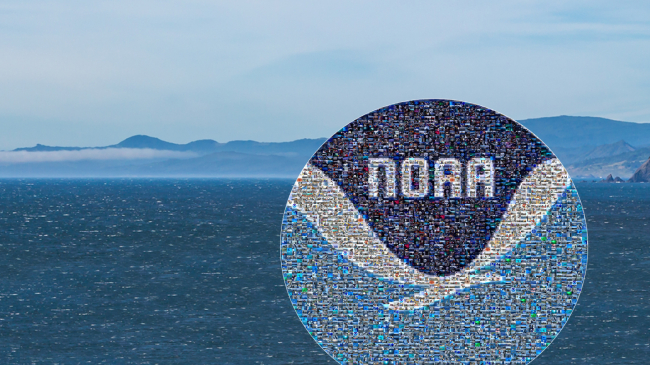
A photo mosaic comprising a large NOAA logo with ocean and mountains near Port Orford, Oregon, in the distance. (Image credit: NOAA )
September 30, 2021, marks the 100th day for NOAA Administrator Rick Spinrad in guiding the agency with three overarching priorities: establishing NOAA as the primary authoritative provider of climate information and services while the nation tackles the climate crisis; integrating equity into our operations; and promoting economic development while maintaining environmental stewardship, with a focus on advancing the Blue Economy.
Underpinning all of the agency’s achievements and day-to-day work is scientific integrity, which is a government-wide priority for the Biden-Harris Administration and a personal priority for Dr. Spinrad, who co-authored the agency's first scientific integrity policy while serving as NOAA's Assistant Administrator for Research (2005-2010) and Chief Scientist (2014-2016).
One of Dr. Spinrad’s first actions as Administrator has been to broaden the dialogue with non-traditional and traditional partners, by engaging with NASA Administrator Nelson, FAA Administrator Dickson, American Medical Association President Resneck, American Society of Civil Engineers President Briaud, insurance industry leaders, and philanthropic organizations — each conversation ending with a commitment to working together more closely.
Dr. Spinrad offers his assessment of these priorities and highlights some of the agency's impressive accomplishments of the last 100 days:
Enhancing NOAA’s climate authority
Dr. Spinrad: “It is my top priority to establish NOAA’s role as the primary authoritative provider of climate products and services that can be applied to a diverse range of missions, just as NOAA is the authoritative provider of weather forecasts, navigational charts, and stock assessments. We play a unique role in that not only do we collect data and conduct research, but we are mandated to make it operational. We provide the public and our federal, state, tribal, and private sector partners with actionable environmental information so they can make decisions in the face of climate change. No matter the need, people will know they can turn to NOAA for reliable, easy-to-use climate information. We are already seeing increasing demands for this, as demonstrated by the record-setting summer of extreme heat, exceptional drought, raging wildfires, unprecedented rains, and damaging hurricanes. The climate crisis is upon us and NOAA is a key part of the whole-of-government response.”
Key accomplishments include:
- Releasing the Chicago Regional Climate Action plan, co-authored by NOAA’s Climate Program Office, that can be a model for other communities on reducing greenhouse gases, and building equitable climate resilience & a sustainable economy.
- Conceived, established, and activated the NOAA Climate Council—the first cross-line office council specifically focused on climate equities, concerns and capabilities, and that reports directly to the Administrator.
- Developed action oriented, impact-based guides for media, and for stakeholders to use to respond more effectively to fire weather, the hurricane season, extreme heat, and drought.
Integrating equity
Dr. Spinrad: “To fully realize NOAA’s mission, we must integrate equity into everything we do. I have made equity a central focus and it is to be embedded in everything we do. Doing so will better position NOAA to help tackle the climate crisis, produce better science, deliver better services, be better stewards of the environment and the economy, and build a more inclusive workforce.”
Key accomplishments include:
- Reaching out to and engaging new groups of stakeholders through a series of Climate and Equity roundtables across the country to understand how NOAA can better serve underserved communities when it comes to the specific climate hazards each region is facing.
- Awarding grants of up to $60 million to HBCUs as part of the agency's continuing long-term commitment to ensuring a future NOAA workforce that is representative of the nation’s population.
- Advancing diversity, equity, inclusion and accessibility at NOAA, including through 12 Employee Resource Groups, We Are NOAA Week, and the Service Equity Assessment Report we conducted in response to Executive Order 13985.
- Launching our TOP prize competition with Census and NOAA to bring in tech innovators to accelerate equitable climate change resilience; and introducing a new content area on NOAA.gov dedicated to environmental justice that features the agency's important equity-related work, from internal workforce initiatives to external services.
Economic development, sustainability, and partnerships
Dr. Spinrad: “One of my top priorities is to bolster sustainable economic development. A key component of accomplishing this is advancing the blue economy, which I define as the knowledge-based ocean economy: looking to the ocean for data, information, and knowledge that can be applied to new, sustainable business development, products, and services in new and traditional ocean-based sectors. The Blue Economy offers opportunities for sustainable, climate-smart innovation and economic growth based on sound science.”
Key accomplishments include:
- NOAA announced a new sanctuary in Lake Michigan, a proposed sanctuary in Lake Ontario, and proposed a new National Estuarine Research Reserve in Connecticut, as consistent with the Administration’s America the Beautiful initiative.
- Helping lead the U.N. Decade of Ocean Science for Sustainable Development (2021-2030), to promote cooperative research and sharing of data to improve understanding of the ocean and its effects on our climate, with implications for transportation, aquaculture, tourism, energy and others.
- To achieve the Administration’s goals of 30 gigawatts of offshore wind by 2030, NOAA has been working closely with the Bureau of Ocean Energy Management to coordinate the siting and permitting process for offshore wind projects.
More: Read Dr. Spinrad's bio.




